Merv: The Heart Of The Silk Road is a new game from the mind of Fabio Lopiano (Ragusa) and the design of Ian O’Toole (Nemo’s War: 2nd Edition, Lisboa).
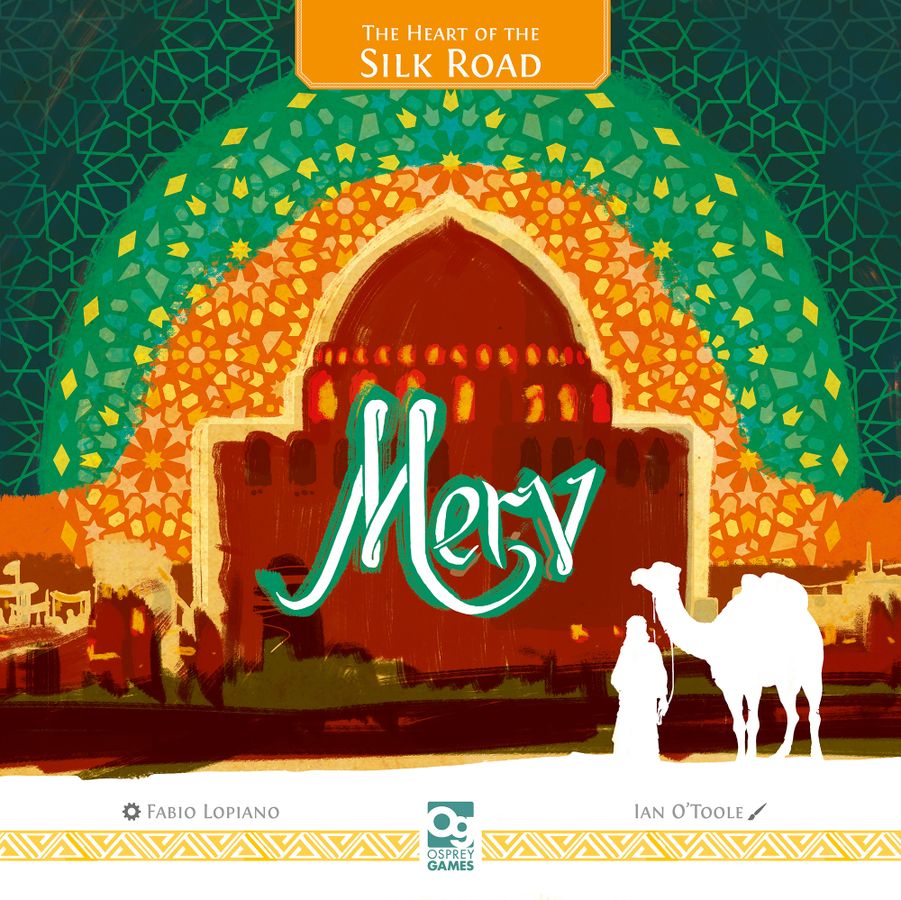
If you’ve never heard of the city of Merv, you’re not alone. I had no idea before I heard about this game. It was a rich, powerful city where East met West, and in the 12th and 13th centuries was one of the biggest cities in the world. It was a major trading hub until the early 13th century when the Mongols sacked the city, reportedly killing the entire population and refugees. Merv never recovered, and was permanently razed in the 18th century, and the rest is history.
Sounds like the perfect setting for a Euro game, right?
What’s In The Box?
Before we get inside the box, let’s just pay attention to the box itself. Wow, it’s a stunner, another beautiful piece of shelf-art from Ian O’Toole. When you open the box, things carry on in the same vein. The board is so colourful and vibrant, as are the cards. There are cards representing spices and contracts, and a whole heap of tiles which represent the buildings in the city, which players will be fighting for control of.
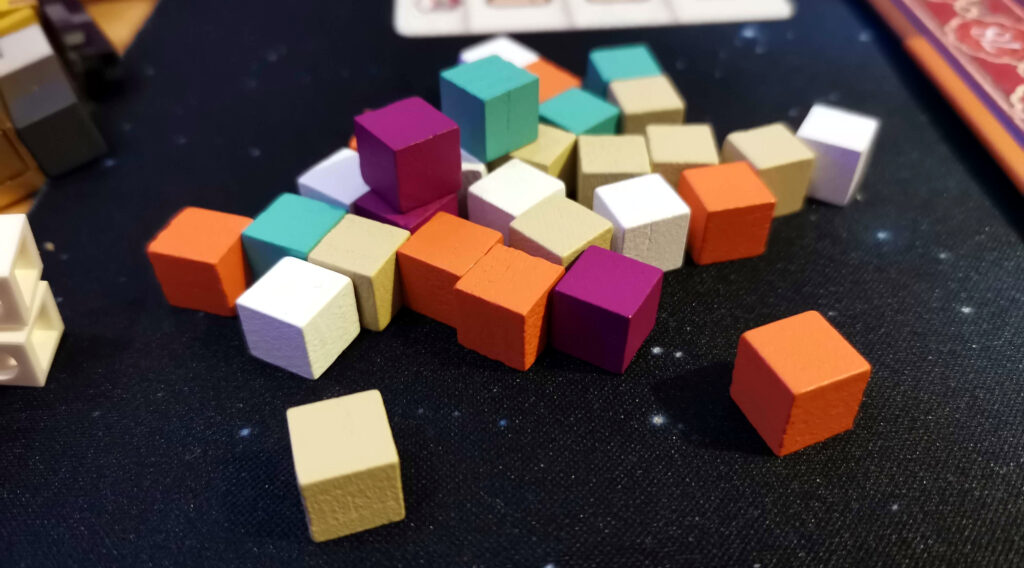
There are wooden pieces for each player, including some meeples, a load of little buildings, and some discs. You’ll be ignoring those though, once you start playing with the gorgeous camel meeples. The rule book is one of the big, square types, and does a really good job of giving examples of each of the actions. It’s worth noting that there are couple of errors in the printing, but only with reference to a couple of compass directions in the solo section.
As you’d expect now, with the artist’s pedigree, the graphic design and iconography throughout is clear, pretty and colourful.
How Does It Play?
Merv is a game of fighting for places in a queue around the city in the middle of the board. A grid of 5×5 has 24 buildings randomly assigned, with a camel market tile in the middle. Surrounding this central area are other areas, including a palace, the mosque track, a marketplace, and the caravans of the surrounding trading outpost. Each of these represents an action you can take on your turn.
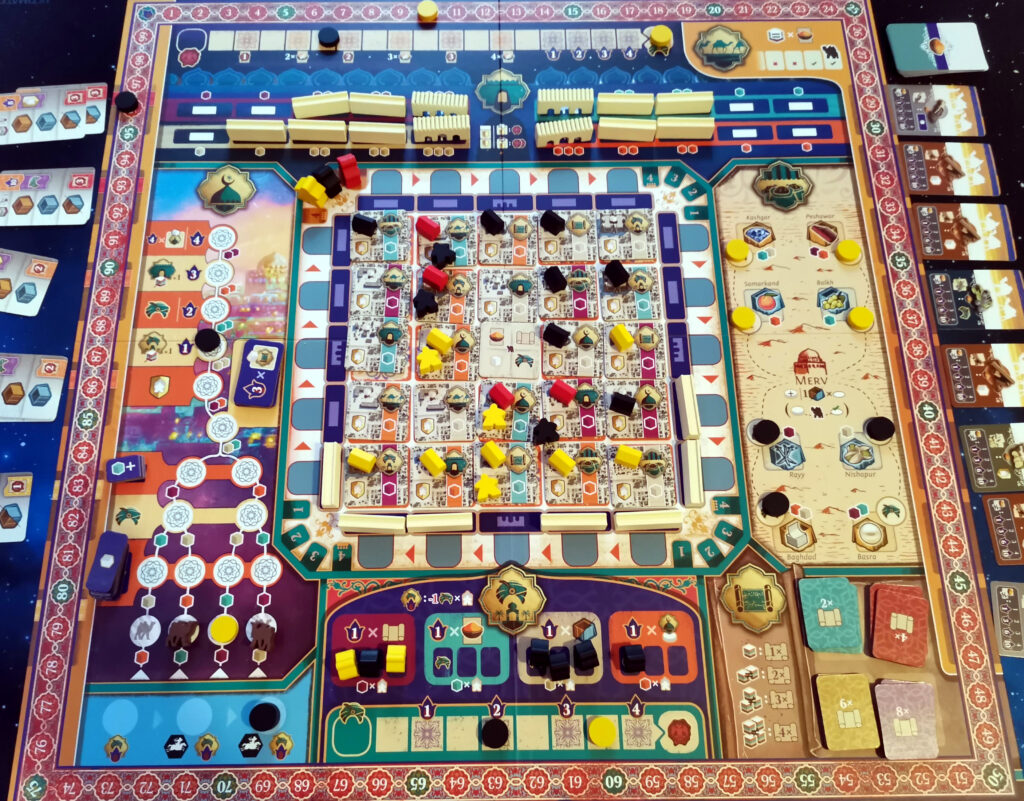
Building Tension
The lifeblood of Merv is fighting for position however. On their turn, the first player in the queue of meeples can choose any column (or row if they’re on the sides) and claim that row or column. They then choose one of the building spaces in that row, and if they have one available, place one of their buildings there. They then own that space.
As well as having an action type, each building space has a colour, and the player first takes a cube of that colour, AND cubes of the colours of all the other buildings they own in that row or column. If you manage to claim all five in a row, that’s five resources per turn. You can immediately understand the importance of trying to get to the front of the queue then, to ensure that it’s you placing your buildings in line with, or perpendicular to, your others .
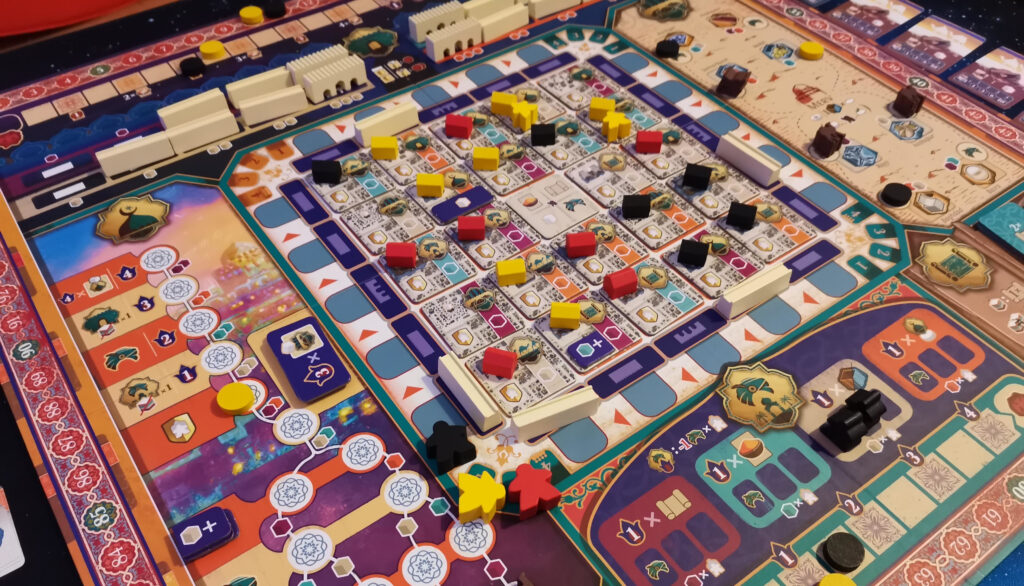
Any cubes you gain from that movement and building, you can now use along with any others in your possession, and spend them performing actions.
Action Stations
Once you’ve collected all those lovely resources, which come in orange, magenta, cyan. beige and white (wild) flavours, you can spend them on the various actions. The Caravansary part of the board lets you build outposts in neighbouring cities, and then spend your cubes on common or luxury goods. The different goods require different colour combinations of cubes. Maybe you’ll choose to trade in spices instead, where you can claim cards of matching types (e.g. ginger, juniper, pepper) if you have matching coloured cubes to spend.
There’s a library you can visit, and in there spending cubes of different colours lets you claim that many transcribed scrolls. Down one side of the board is the mosque track, and advancing along it requires different colours depending on which branch you choose to move along. As you move along it, you’ll unlock various bonuses.
There’s an action that lets you spend ever-increasing amounts of cubes to place a meeple in the palace. These courtiers score you points at the end of each year/round, based on the type of action space you place them in, and how much favour you’ve gained with the palace that year.
Finally, there’s a Walls action, which lets you build walls around the city square. This increases your influence, which is one of the tracks in the game, and protects neighbouring buildings when the Mongols invade at the end of the second and third years.
Wheels Within Wheels
If you know what I like from my reviews, you’ll know I love it when games have things that work together, and bonuses you can stack and combine. Merv does not disappoint. When you’re looking at the various actions available, you’d be forgiven for thinking “which should I go for?”, and the truth is that it doesn’t really matter. They will all gain you VPs, and also different bonuses.
Transcribing scrolls at the library for example. when you collect 2, 4, 6 and finally 8 of them, you can claim one of the breakthrough tiles at each level. They let you do things like have a one-cube discount for certain actions, or let you use one colour as another once per turn, so they can really boost your strategies.
Moving up the mosque track is another option, and with each step you move up, you’ll get additional bonuses, such as tiles you can overlay onto your claimed building sites, which generate an additional cube of a certain colour. Similar tiles can be grabbed by collecting pairs of particular spice cards, and these tiles grant you the white, wild cubes on your chose building instead of the usual colour.
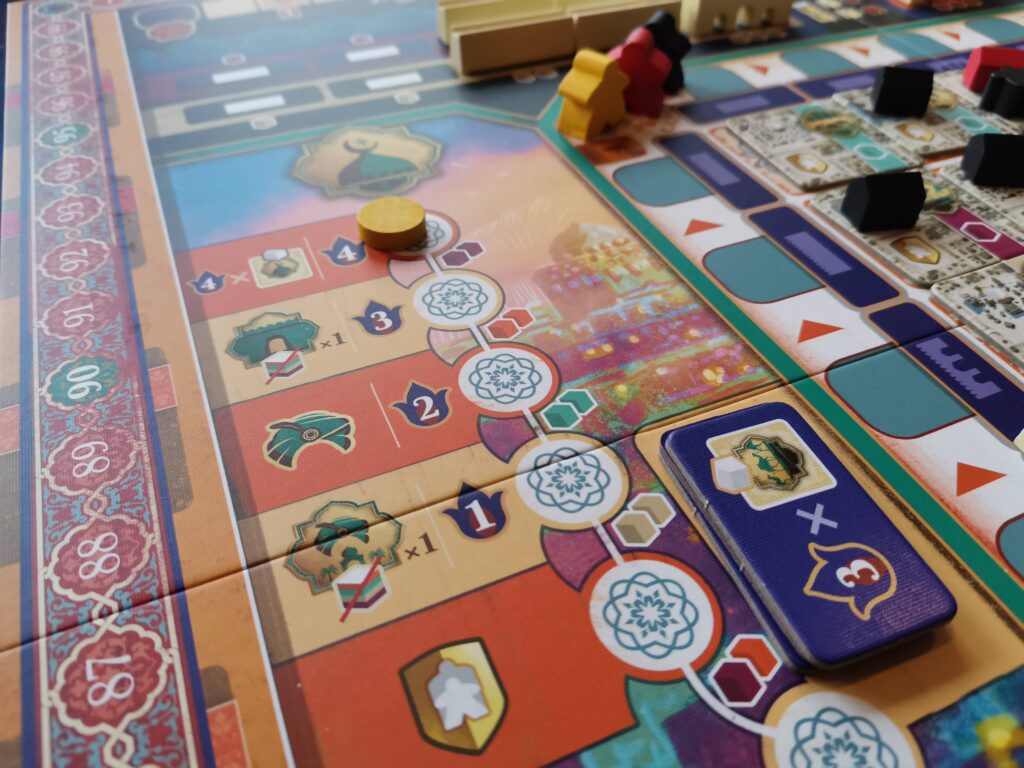
All those goods from the caravansary, and the scrolls from the library, can be turned in to collect contracts, which give you VP bonuses or allow you to place soldiers. Oh, we didn’t talk about soldiers yet did we? Instead of using a building’s action on your turn, you can place a soldier meeple on a built building site to both increase your influence, and to protect it during the Mongol raids.
The Horse Designed By Committee
I mentioned the camels at the top of the review, and I also talked about how important the fight for the queue placement is. So I just want to mention how the two work together. At the end of each turn, the player whose meeple is furthest back along the current row or column, moves it to the queue on the next corner, taking the furthest-back space. Then the next player, then the next, etc. So the player the furthest forward, gets the advantage of going first again next turn.
Or do they?
During the game, various actions will give players camels. These can be spent during certain actions like trading and the caravans, but they can be saved and used to influence the turn order for the next turn. When the first player moves to the next queue, they can put a camel down in each of the spaces they want to skip, so if they have enough, they can put themselves at the front of the queue. The next player can do the same, adding to the camels on each spot, or just take their place and claim any camels there as their own.

This decision of when to spend camels to give you that first player advantage is critical, and makes the seemingly simple choice of ‘which row do I claim this turn?’ much harder.
After three trips around the board, which represents three years, the game ends and the player with the most points wins.
Final Thoughts
Merv is a great game, let’s just get that out of the way now. I really, really like the game. Fabio has put together some really well-connected mechanics and the decision-making involved is fantastic. After a couple of games, once I understood the interplay of difference actions and resources, I could really start trying to play with some form of strategy.
Merv For Dummies
One of the biggest complaints I see about the game – mostly from people who haven’t played it – is that they won’t play a game with a dummy player in. Some games have used a dummy, extra player to occupy space and make mechanics work with lower player counts. It’s usually a lazy way to not cope with making changes to the game with those lower player counts. In Merv if you play with one or two players, an additional character is added to the game, the High Courtier (HC).
At a glance, you’d be mistaken for thinking this is a dummy player, but it’s really not. Each turn, the first player chooses which row or column the HC claims, and the second player chooses which building plot they build on. Rather than just blocking though, this placement is very tactical. One thing I didn’t mention in the gameplay overview is that on your turn, instead of activating your own buildings, you can choose to activate another player’s, or the HC’s, and take their actions and cubes. Once you understand that, you can see how playing those extra buildings not only blocks other players, but can be a really useful resource for you.
Reactive Planning
The layout of the city tiles is randomised each time you play, and reading that initial state is the key to doing well, and I love that in a game. The same goes for the spice cards too, the deck is shuffled and the initial layout different each time. Even when you’ve got the initial read of things, and you start formulating a plan, you still need to be so reactive, especially in the first year. Players will get in your way, block your rows, take the things you had your eye on, and you’ve got to have a Plan B, and a Plan C, just in case.
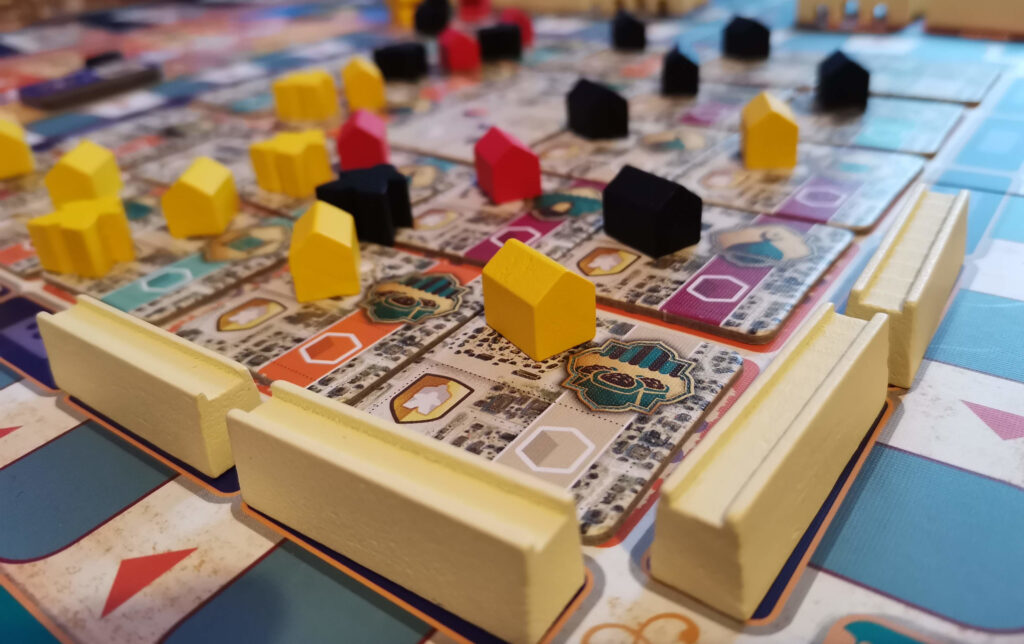
This could lead to a really frustrating situation if it was left unchecked, as a good player could lock up really useful places and leave the others limited for options. However, turns are finite, and each player only gets 12 over the course of the game. Unless players spend some of those turns placing soldiers of building walls, they’re likely to lose some of those buildings during the Mongol raid at the end of the second year. Those spots are then fair game during the final year for the other players to claim and build on.
As well as the various actions and resources, there are also two main tracks that come into play. The influence track determines how many different types of spice you can trade for, and which value of contract you can fulfill, while the honour track is spent at the end of each year to score points for the courtiers you might have in the palace.
Putting It All Together
Some people have said there are dominant strategies and actions to take in Merv, but personally I’ve not witnessed it. I’ve won and lost games to players concentrating on different things. When I’ve made conscious efforts to just climb the mosque track, or just build outposts and dominate the caravansary, I’ve won and lost.
Merv just feels great to play. Even setting it up on the table, with all the bright colours and illustrations, puts a smile on your face. Turns are so simple, and there’s very little fuss in doing anything in the game. This combined with the clear iconography means that after just one learning play of the game, you can concentrate on your strategy. There’s no hidden information, so any strategies are yours to figure out, if you know your opponents well enough.
I have a love/hate relationship with games with a limited number of turns. You never have enough turns to do everything, and those 12 turns disappear quickly. To do well you have to set out your stall early and decide: am I going to be Jack of all trades and master of none, or am I Captain Library for the next hour.
Merv is a game that just feels satisfying. When you start the game there’s this empty city square, and by the end it’s covered in buildings, soldiers and upgrades, and walls and gates surround it. It’s not a town or civilization building game, but it gives that look and feel to all involved.
Solo Options
There’s a really well-made solo game in the box, and it’s with an automa opponent (yay!). Your foe in this mode is called the Corrupt Magistrate, and its actions are driven by a deck of cards. The way its deck is created is clever too, as it will concentrate on three of the main actions, and the palace, and you don’t know which it will be until you start playing. The rules for it placing buildings and taking actions are very clear and easy, and the two of you also drive the actions of the High Courtier, as per the two-player game.
As I mentioned above, in the current printing there are a couple of areas in the solo rules that don’t make sense. It refers to both the cities on the caravansary area, and the trails on the mosque area as if they were both rotated 90 degrees clockwise, but once you understand that, it’s all clear. It comes as a result of the solo rules going to print before the design of the board was finalised.
Recommended?
Absolutely. If you like your Euros with quite a lot of indirect player interaction (the blocking) and plenty of routes to victory, this is a fantastic option. The solo mode is very good, and hard to beat, which is a real boon during these times of lockdown, at the time of writing. It’s quick to learn, easy to understand, and it’s a beautiful thing to have on your shelf and table. Gamers and non-gamers alike can’t help to be drawn in by the colours, the walls around the city, and of course, my favourite, those wonderful little camels.
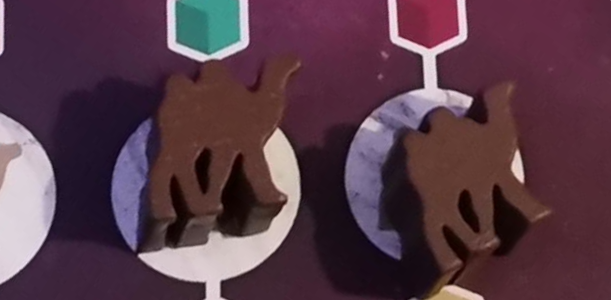
I don’t know about the rest of the world, but in the UK, if you shop around you can buy Merv for less than £30. For that price, it’s hard to find a reason to not buy it.
